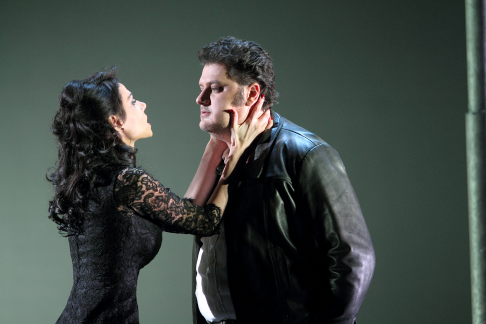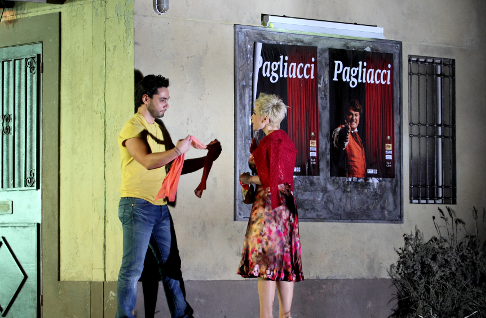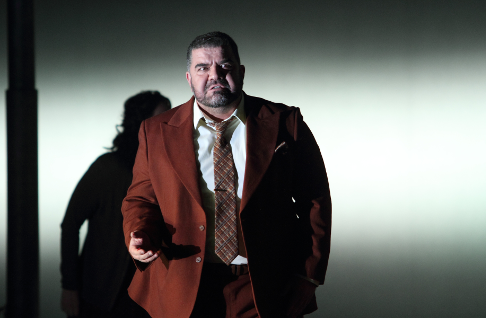![Eva-Maria Westbroek as Santuzza [Photo © ROH. Photographer Catherine Ashmore]](http://www.operatoday.com/2737ashm_1052.png)
10 Dec 2015
Cav/Pag at Royal Opera
When Italian director Damiano Michieletto visited Covent Garden in June this year, he spiced Rossini’s Guillaume Tell with a graphic and, many felt, gratuitous rape scene that caused outrage and protest.
English Touring Opera are delighted to announce a season of lyric monodramas to tour nationally from October to December. The season features music for solo singer and piano by Argento, Britten, Tippett and Shostakovich with a bold and inventive approach to making opera during social distancing.
This tenth of ten Live from London concerts was in fact a recorded live performance from California. It was no less enjoyable for that, and it was also uplifting to learn that this wasn’t in fact the ‘last’ LfL event that we will be able to enjoy, courtesy of VOCES8 and their fellow vocal ensembles (more below …).
Ever since Wigmore Hall announced their superb series of autumn concerts, all streamed live and available free of charge, I’d been looking forward to this song recital by Ian Bostridge and Imogen Cooper.
Although Stile Antico’s programme article for their Live from London recital introduced their selection from the many treasures of the English Renaissance in the context of the theological debates and upheavals of the Tudor and Elizabethan years, their performance was more evocative of private chamber music than of public liturgy.
Evidently, face masks don’t stifle appreciative “Bravo!”s. And, reducing audience numbers doesn’t lower the volume of such acclamations. For, the audience at Wigmore Hall gave soprano Elizabeth Llewellyn and pianist Simon Lepper a greatly deserved warm reception and hearty response following this lunchtime recital of late-Romantic song.
For this week’s Live from London vocal recital we moved from the home of VOCES8, St Anne and St Agnes in the City of London, to Kings Place, where The Sixteen - who have been associate artists at the venue for some time - presented a programme of music and words bound together by the theme of ‘reflection’.
'Such is your divine Disposation that both you excellently understand, and royally entertaine the Exercise of Musicke.’
‘And there was war in heaven: Michael and his angels fought against the dragon; and the dragon fought and his angels, And prevailed not; neither was their place found any more in heaven … that old serpent … Satan, which deceiveth the whole world: he was cast out into the earth, and his angels were cast out with him.’
There was never any doubt that the fifth of the twelve Met Stars Live in Concert broadcasts was going to be a palpably intense and vivid event, as well as a musically stunning and theatrically enervating experience.
‘Love’ was the theme for this Live from London performance by Apollo5. Given the complexity and diversity of that human emotion, and Apollo5’s reputation for versatility and diverse repertoire, ranging from Renaissance choral music to jazz, from contemporary classical works to popular song, it was no surprise that their programme spanned 500 years and several musical styles.
The Academy of St Martin in the Fields have titled their autumn series of eight concerts - which are taking place at 5pm and 7.30pm on two Saturdays each month at their home venue in Trafalgar Square, and being filmed for streaming the following Thursday - ‘re:connect’.
The London Symphony Orchestra opened their Autumn 2020 season with a homage to Oliver Knussen, who died at the age of 66 in July 2018. The programme traced a national musical lineage through the twentieth century, from Britten to Knussen, on to Mark-Anthony Turnage, and entwining the LSO and Rattle too.
With the Live from London digital vocal festival entering the second half of the series, the festival’s host, VOCES8, returned to their home at St Annes and St Agnes in the City of London to present a sequence of ‘Choral Dances’ - vocal music inspired by dance, embracing diverse genres from the Renaissance madrigal to swing jazz.
Just a few unison string wriggles from the opening of Mozart’s overture to Le nozze di Figaro are enough to make any opera-lover perch on the edge of their seat, in excited anticipation of the drama in music to come, so there could be no other curtain-raiser for this Gala Concert at the Royal Opera House, the latest instalment from ‘their House’ to ‘our houses’.
"Before the ending of the day, creator of all things, we pray that, with your accustomed mercy, you may watch over us."
The doors at The Metropolitan Opera will not open to live audiences until 2021 at the earliest, and the likelihood of normal operatic life resuming in cities around the world looks but a distant dream at present. But, while we may not be invited from our homes into the opera house for some time yet, with its free daily screenings of past productions and its pay-per-view Met Stars Live in Concert series, the Met continues to bring opera into our homes.
Music-making at this year’s Grange Festival Opera may have fallen silent in June and July, but the country house and extensive grounds of The Grange provided an ideal setting for a weekend of twelve specially conceived ‘promenade’ performances encompassing music and dance.
There’s a “slide of harmony” and “all the bones leave your body at that moment and you collapse to the floor, it’s so extraordinary.”
“Music for a while, shall all your cares beguile.”
The hum of bees rising from myriad scented blooms; gentle strains of birdsong; the cheerful chatter of picnickers beside a still lake; decorous thwacks of leather on willow; song and music floating through the warm evening air.
![Eva-Maria Westbroek as Santuzza [Photo © ROH. Photographer Catherine Ashmore]](http://www.operatoday.com/2737ashm_1052.png)
When Italian director Damiano Michieletto visited Covent Garden in June this year, he spiced Rossini’s Guillaume Tell with a graphic and, many felt, gratuitous rape scene that caused outrage and protest.
The perennial verismo partners, Pietro Mascagni’s 1890 one-act opera Cavalleria Rusticana and Ruggero Leoncavallo’s Pagliacci, have little need for any such directorial enhancement: passions reach stratospheric heights, the sordid sits alongside the sensational, and violent vengeance is rife.
Sexual infidelity and vigilante justice are at the heart of both operas. Michieletto entwines the works even more tightly together by setting them in the same late twentieth-century south Italian backwater, and by allowing the characters to wander between the two dramas. So, during the impassioned intermezzo of Cavalleria we see an assistant at the baker’s shop — on the walls of which Beppe has posted bills for the forthcoming performance of Pagliacci — tentatively approach a stylish young woman, proffer a gift, a silk scarf, and snatch a hasty embrace. Later, we understand that this was the first romantic encounter of Silvio and Nedda, whose illicit love will bring heartbreak to the commedia troupe in Pagliacci. Then, the equivalent instrumental interlude in Pagliacci witnesses the emotional reconciliation of the now-pregnant Santuzza with Turridu’s bereaved mother.
 Martina Belli as Lola and Aleksandrs Antonenko as Turiddu
Martina Belli as Lola and Aleksandrs Antonenko as Turiddu
I’m not sure that such interlacing achieves much. Moreover, there is other directorial meddling that I found downright distracting, such as the presentation, in the form of a tableau, of Cavalleria’s final scene during the opera’s overture. The curtain lifts to present a prone figure in a shabby piazza, gloomily lit by the dull beam of a single lamp-post. Then, the bereft matriarch, Mamma Lucia, fretfully pushes her way through the shocked crowd of onlookers, discovers her dead son, and mimes an agony of bereavement as his body is borne away, aloft, to the strains of the Easter hymn. Given that so little actually happens in the course of the opera, and that the drama relies on the ratcheting up of the tension between the ill-fated lovers, does it make sense to give us the tragic ending before we’ve started?
Perhaps it explains why the entire action of Cavalleria seems to take place at night, though: we are in the shadow of death? The set doesn’t help to create a sense of forward momentum either, consisting as it does of a shrub-lined piazza and a run-down Panificio which revolve, unceasingly, transferring us back and forth, between the shop’s interior and exterior. Earlier this year, I noted that designer Paolo Fantin’s set for Michieletto’s Tell was dominated by a huge, uprooted tree, ‘horizontal and enlarged, its twisting branches and gnarled roots etch and score sharp gothic shadows onto the bare skies beyond’, which despite its visual impact was ‘a hindrance to movement … the fallen trunk can revolve to reveal different locations but there is little meaningful choreography within those locations’. The same might be said here of Fantin’s bakery which, though characterised by evocative period detail, limits the stage space available for the Chorus. Michieletto does little with the latter, in any case.
 Dionysios Sourbis as Silvio and Carmen Giannattasio as Nedda
Dionysios Sourbis as Silvio and Carmen Giannattasio as Nedda
The design of Pagliacci re-configures the revolve into a simple, and much more successful, arrangement of interlocking walls which make up various rooms within a ramshackle community centre: the troupe’s dressing room, a bare hall and the auditorium itself. During the commedia performance, Michieletto cleverly highlights the theatre/reality dichotomy by using ‘doubles’ to step into the action on stage, while the ‘real’ protagonists step behind-the-scenes and Canio is taunted by Tonio and Nedda (as Taddeo and Columbina) in his dressing-room. The stage upon which they perform is ridiculously small too, adding to the sense of discomfort — the passions enacted are too vast to be squeezed onto the tiny platform, and the red of the proscenium frame is a like a bloody gash, a sign that carnage is inevitable.
The performers, on stage and in the pit, gave a truly persuasive account of both operas, but it was Pagliacci which saw the singers shine brightest. Aleksandrs Antonenko was a hard-hearted Turiddu — I couldn’t believe in his appeals to his mother to watch over Santuzza should anything happen to him — but his voice was warm and ringing, if a little insecure at the top. The role of Canio suited him better and, driven to near madness by Nedd’s refusal to name her lover, he gave an intense and emotionally wrought rendition of ‘Vesti la giubba’, forcing himself to prepare for the performance ahead. This was a high-point of the evening; here, the despair was absolute and genuine, reaching out to us beyond Canio’s twisted malice.
Dmitri Platanias, one of two Greek baritones in the cast, doubled as Alfio and Tonio. The former role did not ask much of him: returning from the ‘open road’, he lifted the boot of his battered Fiat and showered the expectant villagers with faux designer handbags and the latest fashions, picked up on his travels; but otherwise this Alfio did not always seem entirely engaged in the drama. However, as Tonio, Platanias’s baritone acquired fullness and suavity; the prologue of Pagliacci was riveting from the first, and he introduced nuances to his voice that had been absent in Cavalleria.
 Dimitri Platanias as Alfio
Dimitri Platanias as Alfio
Eva-Maria Westbroek was vocally fervent as the emotionally and morally tormented Santuzza, and gave her all dramatically; but, Westbroek used an overly wide vibrato to beef up the sound which at times affected the intonation — her duet with Alfio was particularly askew — and the soprano’s tone lacked a consistent glossiness and ripeness. Martina Belli, making her ROH debut, was a glamorous Lola debut, sparkling with cruel insouciance. Mezzo soprano Elena Zilio was affecting as Mamma Lucia; despite her stern façade, her devotion to her son was ever apparent — though her histrionics in the overture seemed out of keeping the strict self-control this matriarch exhibited elsewhere.
In Pagliacci, Carmen Giannattasio was superb as Nedda: the beauty of her voice was tinged with a slight steeliness, capturing Nedda’s allure and capriciousness. British tenor Benjamin Hulett (Beppe) and Platanias’s compatriot Dionysios Sourbis (Silvio) completed a fine cast.
Antonio Pappano may have been born in Epping and lived in the US, but his family roots lie in southern Italy, and here he showed that he has this music in his blood. In a recent interview in the Guardian, the conductor emphasised his commitment to these operas, despite their melodramatic clichés: ‘all those clichés are genuine. Go to Italian villages even today and you’ll still see the old women dressed in black and the villagers will look at you differently if you are a stranger. The Madonna being carried in the parades at Easter might look corny on stage, but it is not an invention. It happens. And while some of these images are easy to poke fun at, they are also compelling and authentic, especially in the south.’ And, Pappano drew an impassioned and unstinting performance from the ROH orchestra. Most notably, he underlined the score’s juxtapositions of softness and sentimentality with malevolence and viciousness, switching between the two with unnerving volte faces which helped to convey the volatility and impulsiveness of the lovers. Violins, flute and harp created sweetness but were repeatedly swept aside by the cello’s darkness. The ROH Chorus was in resounding voice, too, and the Easter Hymn swelled gloriously.
Michieletto ensures that both operas make an immediate emotional impact, but it is in Pagliacci that the melodrama builds with excruciating inescapability towards its murderous final moments. Canio’s closing words, ‘La commedia è finita!’, were chilling, just as the psychological drama presented was horrifically real.
Claire Seymour
Cast and production information:
Cavalleria Rusticana : Santuzza — Eva-Maria Westbroek, Turiddu —Aleksandrs Antonenko, Mamma Lucia —Elena Zilio, Alfio —Dimitri Platanias, Lola — Martina Belli.
Pagliacci : Canio — Aleksandrs Antonenko, Tonio — Dimitri Platanias, Nedda — Carmen Giannattasio, Beppe — Benjamin Hulett, Silvio — Dionysios Sourbis.
Director — Damiano Michieletto, Conductor —Antonio Pappano, Set designs —Paolo Fantin, Costume designs —Carla Teti, Lighting design — Alessandro Carletti, Orchestra of the Royal Opera House, Royal Opera Chorus.
Royal Opera House, Covent Garden, London, Monday 7th December 2015.